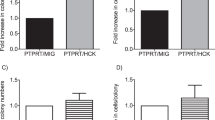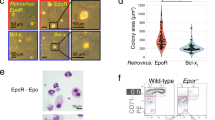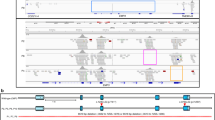Abstract
THE receptors for erythropoietin and other cytokines constitute a new superfamily1–4. They have no tyrosine-kinase or other enzyme motif and their signal-transducing mechanism is unclear. Here we describe two classes of activating mutations in the erythropoietin receptor (EPOR). A single point mutation in the exoplasmic domain enables it to induce hormone-independent cell growth and tumorigenesis after expression in nontumorigenic, interleukin-3-dependent haematopoietic cells. A C-terminal truncation in the cytoplasmic domain of the EPOR renders the receptor hyper-responsive to erythropoietin, but is insufficient to induce hormone-independent growth or tumorigenicity. The activating point mutation retards intracellular transport and turnover of the receptor. These alterations in metabolism and tumorigenicity caused by the EPOR with activating point mutations are similar to those observed in erythropoietin-independent activation of the wild type EPOR by association with gp55, the Friend spleen focus-forming virus glycoprotein5,6.
This is a preview of subscription content, access via your institution
Access options
Subscribe to this journal
Receive 51 print issues and online access
$199.00 per year
only $3.90 per issue
Buy this article
- Purchase on Springer Link
- Instant access to full article PDF
Prices may be subject to local taxes which are calculated during checkout
Similar content being viewed by others
References
D'Andrea, A. D., Fasman, G. D. & Lodish, H. F. Cell 58, 1023–1024 (1989).
Itoh, N. et al. Science 247, 324–327 (1990).
Bazan, J. F. Biochem. biophys. Res. Commun. 164, 788–795 (1989).
Fukunaga, R., Ikeda, E. I., Seto, Y. & Nagata, S. Cell 61, 341–350 (1990).
Li, J.-P., D'Andrea, A. D., Lodish, H. F. & Baltimore, D. Nature 343, 762–764 (1990).
Yoshimura, A., D'Andrea, A. D. & Lodish, H. F. Proc. natn. Acad. Sci. U.S.A. 87, 4139–4143 (1990).
D'Andrea, A. D., Lodish, H. F. & Wong, G. G. Cell 57, 277–285 (1989).
Hatakeyama, M., Mori, H., Doi, T. & Taniguchi, T. Cell 59, 837–845 (1989).
Bestwick, R. K., Kozak, S. L. & Kabat, D. Proc. natn. Acad. Sci. U.S.A. 85, 5404–5408 (1988).
Danos, O. & Mulligan, R. C. Proc. natn. Acad. Sci. U.S.A. 85, 6460–6464 (1988).
Saiki, R. K. et al. Science 239, 487–491 (1988).
Sanger, F., Nicklen, S. & Coulson, A. R. Proc. natn. Acad. Sci. U.S.A. 74, 5463–5467 (1977).
Woolford, J., McAuliffe, A. & Rohrschneider, L. R. Cell 55, 965–977 (1988).
Roussel, M. F., Downing, J. R., Rettenmier, C. W. & Sherr, C. J. Cell 55, 979–988 (1988).
Roussel, et al. Nature 325, 549–552 (1987).
Roussel, M. F., Downing, J. R. & Sherr, C. J. Oncogene 5, 25–30 (1990).
Schrader, J. W. & Crapper, R. M. Proc. natn. Acad. Sci. U.S.A. 80, 6892–6896 (1983).
Schrader, J. W. A. Rev. Immun. 4, 205–230 (1986).
Taga, T. & Kishimoto, T. Curr. Op. Cell Biol. 2, 174–180 (1990).
Lang, R. A., Metcalf, D., Gough, N. M., Dunn, A. R. & Gonda, T. J. Cell 43, 531–542 (1985).
Author information
Authors and Affiliations
Rights and permissions
About this article
Cite this article
Yoshimura, A., Longmore, G. & Lodish, H. Point mutation in the exoplasmic domain of the erythropoietin receptor resulting in hormone-independent activation and tumorigenicity. Nature 348, 647–649 (1990). https://doi.org/10.1038/348647a0
Received:
Accepted:
Issue Date:
DOI: https://doi.org/10.1038/348647a0
This article is cited by
-
Hereditary gene mutations in Korean patients with isolated erythrocytosis
Annals of Hematology (2014)
-
JAK/STAT signaling in hematological malignancies
Oncogene (2013)
-
Expression of constitutively active erythropoietin receptor in pyramidal neurons of cortex and hippocampus boosts higher cognitive functions in mice
BMC Biology (2011)
-
Mechanistic basis of pre–T cell receptor–mediated autonomous signaling critical for thymocyte development
Nature Immunology (2006)
Comments
By submitting a comment you agree to abide by our Terms and Community Guidelines. If you find something abusive or that does not comply with our terms or guidelines please flag it as inappropriate.



